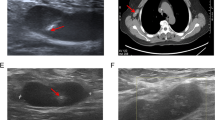Abstract
The purpose of this study was to understand the short-term therapeutic effects of an activated carbon nanoparticle–epirubicin suspension for regional lymphatic chemotherapy in patients with breast cancer. One hundred and twenty patients with stage I, II, or III primary breast cancer were randomly divided into three groups: the lymphatic chemotherapy group using the activated carbon nanoparticle–epirubicin suspension, the epirubicin control group, and the activated carbon control group. Each group of 40 patients was further divided into two subgroups with the drug injected either 24 or 48 h before surgery. The terminal deoxynucleotidyl transferase–mediated deoxyuridine triphosphate–biotin nick end labeling (TUNEL) assay was used to determine cancer cell apoptotic indices in metastatic lymph nodes. The epirubicin concentration in the black-stained lymph nodes in the lymphatic chemotherapy treatment group was 4,144.64 ± 2,426.44 ng/g, which is significantly higher than in the epirubicin control group (335.87 ± 212.82 ng/g, P < 0.001). The plasma epirubicin concentrations at 0.5, 1.5, and 24 h postinjection in the regional lymphatic chemotherapy treatment group were significantly lower than in the epirubicin control group (P < 0.001). Tolerable mild pain was observed at the injection area after administration of the epirubicin–activated carbon nanoparticle suspension. No regional necrosis or adverse effects were found. The TUNEL assay demonstrated that there was no significant difference in the apoptotic indices in the metastatic lymph nodes from the three groups. Performing lymphatic chemotherapy by regionally injecting the epirubicin–activated carbon nanoparticle suspension could significantly enhance the drug concentration in the stained lymph nodes and lower the plasma drug concentration. The epirubicin–activated carbon nanoparticle suspension has the ability to release the drug slowly in the lymph nodes and, as a result, can prolong the chemotherapeutic effects.


Similar content being viewed by others
References
Parkin DM, Bray F, Ferlay J, Pisani P. Global cancer statistics, 2002. CA Cancer J Clin. 2005;55(2):74–108.
Papademetriou K, Ardavanis A, Kountourakis P. Neoadjuvant therapy for locally advanced breast cancer: focus on chemotherapy and biological targeted treatments’ armamentarium. J Thorac Dis. 2010;2(3):160–70.
Wheeler SB, Reeder-Hayes K, Meyer AM. A balancing act for breast cancer? Everolimus for hormone receptor positive patients. Transl Cancer Res. 2012;1(2):109–12.
Fan F. Sentinel lymph node micrometastases and isolated tumor cells in breast cancer: an evolving field. Gland Surg. 2012;1(1):5–6.
Morrow M, Evans J, Rosen PP, Kinne DW. Does clearing of axillary lymph nodes contribute to accurate staging of breast carcinoma? Cancer. 1984;53(6):1329–32.
Bernet L, Cano R. Metastatic sentinel node and axillary lymphadenectomy revisited. Gland Surg. 2012;1(1):7–8.
Tanigawa N, Satomura K, Hikasa Y, Hashida M, Muranishi S, Sezaki H. Surgical chemotherapy against lymph node metastases: an experimental study. Surgery. 1980;87(2):147–52.
Chen J, Wang L, Yao Q, Ling R, Li K, Wang H. Drug concentrations in axillary lymph nodes after lymphatic chemotherapy on patients with breast cancer. Breast Cancer Res. 2004;6(4):R474–7.
Overgaard J, Bartelink H. Breast cancer survival advantage with radiotherapy. Lancet. 2000;356(9237):1269–70.
Ragaz J, Jackson SM, Le N, Plenderleith IH, Spinelli JJ, Basco VE, et al. Adjuvant radiotherapy and chemotherapy in node-positive premenopausal women with breast cancer. N Engl J Med. 1997;337(14):956–62.
Early Breast Cancer Trialists’ Collaborative Group. Effects of radiotherapy and surgery in early breast cancer. An overview of the randomized trials. N Engl J Med. 1995;333(22):1444–55.
Early Breast Cancer Trialists’ Collaborative Group. Favourable and unfavourable effects on long-term survival of radiotherapy for early breast cancer: an overview of the randomised trials. Lancet. 2000;355(9217):1757–70.
Kegel FS, Rietman BM, Verliefde AR. Reverse osmosis followed by activated carbon filtration for efficient removal of organic micropollutants from river bank filtrate. Water Sci Technol. 2010;61(10):2603–10.
Bu L, Wang K, Zhao QL, Wei LL, Zhang J, Yang JC. Characterization of dissolved organic matter during landfill leachate treatment by sequencing batch reactor, aeration corrosive cell-Fenton, and granular activated carbon in series. J Hazard Mater. 2010;179(1–3):1096–105.
Sze MF, McKay G. An adsorption diffusion model for removal of para-chlorophenol by activated carbon derived from bituminous coal. Environ Pollut. 2010;158(5):1669–74.
Yokota T, Saito T, Narushima Y, Iwamoto K, Iizuka M, Hagiwara A, et al. Lymph-node staining with activated carbon CH40: a new method for axillary lymph-node dissection in breast cancer. Can J Surg. 2000;43(3):191–6.
Hagiwara A, Takahashi T, Sawai K, Sakakura C, Shirasu M, Ohgaki M, et al. Selective drug delivery to peri-tumoral region and regional lymphatics by local injection of aclarubicin adsorbed on activated carbon particles in patients with breast cancer—a pilot study. Anticancer Drugs. 1997;8(7):666–70.
Sledge GW, Neuberg D, Bernardo P, Ingle JN, Martino S, Rowinsky EK, et al. Phase III trial of doxorubicin, paclitaxel, and the combination of doxorubicin and paclitaxel as front-line chemotherapy for metastatic breast cancer: an intergroup trial (E1193). J Clin Oncol. 2003;21(4):588–92.
Conflicts of interest
None.
Author information
Authors and Affiliations
Corresponding author
Rights and permissions
About this article
Cite this article
Yang, Q., Wang, Xd., Chen, J. et al. A clinical study on regional lymphatic chemotherapy using an activated carbon nanoparticle–epirubicin in patients with breast cancer. Tumor Biol. 33, 2341–2348 (2012). https://doi.org/10.1007/s13277-012-0496-y
Received:
Accepted:
Published:
Issue Date:
DOI: https://doi.org/10.1007/s13277-012-0496-y




